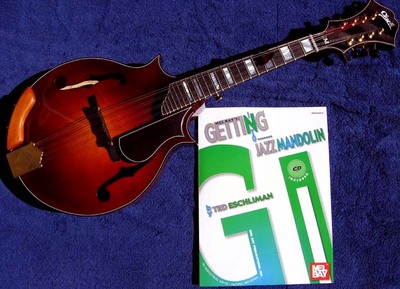« New models from JBovier Mandolins |
Main
| Mandolin Cafe Ball Caps. Today's the day! »
 February 16, 2011 | American String Teacher's Journal review February 16, 2011 | American String Teacher's Journal review
 We were thrilled to have "Getting to Jazz Mandolin" reviewed in the recent November issue of the American String Teacher's Journal. The educational organization doesn't usually pay much attention to the fretted side, but an occasional mention happens our way, and in this case, thanks to frequent contributor, Dr. Robert Woody, Sr., Professor at the University of Nebraska at Omaha. A talented multi-instrumentalist himself, "Doc" is a devoted fan of the mandolin, and has also contributed articles to Mandolin Quarterly, and is highly read in the area of Psychology, as well as Music Education. We're grateful for his kind words: We were thrilled to have "Getting to Jazz Mandolin" reviewed in the recent November issue of the American String Teacher's Journal. The educational organization doesn't usually pay much attention to the fretted side, but an occasional mention happens our way, and in this case, thanks to frequent contributor, Dr. Robert Woody, Sr., Professor at the University of Nebraska at Omaha. A talented multi-instrumentalist himself, "Doc" is a devoted fan of the mandolin, and has also contributed articles to Mandolin Quarterly, and is highly read in the area of Psychology, as well as Music Education. We're grateful for his kind words:
From the article: "Contemporary mandolin materials tend to be in the bluegrass genre or collections of simple tunes. Such sources provide basic information, but seldom venture into a sequence of learning experiences beyond fundamentals. Getting to Jazz Mandolin is unique. It seeks to provide information in a progressive manner, with emphasis on theory and practical (but creative) finger patterns.
Eschliman uses homespun language, sometimes a bit 'folksy' to explain theoretical idea and offer understandable linkage to technique. Arpeggios for a variety of chords and inversions, numerous drills, altered scales, cadences, comping, and progressions further the jazz objective. Labels are applied to imprint the interaction between scales and chord patterns.
The 'getting to jazz' concept is the basis for learning the full fingerboard (many mandolin methods neglect the upper positions). In keeping with the importance of scales for appreciating music, Eschliman blends the emphasis on fingering into modes, such as advancing scale-based passages upward, with introducing the concepts of intervals and chords. The fixed four finger closed position (FFcP) is emphasized, and its application on different strings and at different frets.
The book expects the student to have solid knowledge of music and at least intermediate (if not advanced) performance competency. Eschliman points out that the learning experience requires fingers, ears, and brain. Within his approach to jazz mandolin, the "brain" is certainly a critical aspect. An extensive set of support materials and articles are available on his website (www.jazzmando.com). This book and CD is valuable for teaching others or oneself or developing a scholarly approach to jazz mandolin."
American String Teacher website: ASTA
Purchase book Getting into Jazz Mandolin

Posted by Ted at February 16, 2011 5:36 AM

Disclaimer: In the 'Information Age' of the 21st Century,
any fool with a computer, a modem, and an idea can
become a self-professed 'expert." This site does not
come equipped with 'discernment.'
|



